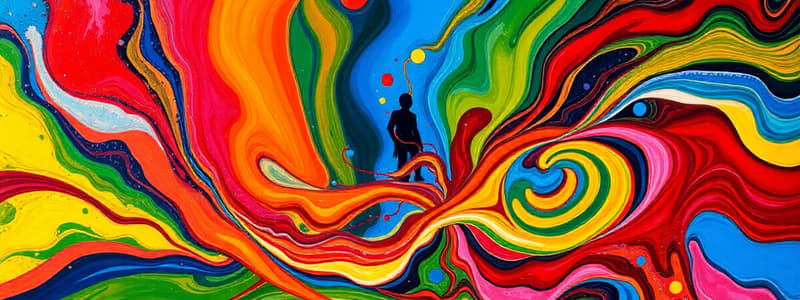Podcast
Questions and Answers
What happens to a substance's temperature during the boiling process?
What happens to a substance's temperature during the boiling process?
- It remains constant until all particles have vaporized. (correct)
- It increases steadily.
- It decreases slowly.
- It fluctuates randomly.
What is required for a particle to evaporate from a liquid surface?
What is required for a particle to evaporate from a liquid surface?
- A decrease in the liquid's surface area.
- A drop in surrounding temperature.
- Enough energy to overcome air pressure. (correct)
- Less energy than the attractive forces.
What is the process called when a gas loses thermal energy and turns into a liquid?
What is the process called when a gas loses thermal energy and turns into a liquid?
- Sublimation
- Condensation (correct)
- Evaporation
- Melting
What occurs during the freezing process of a liquid?
What occurs during the freezing process of a liquid?
Which of the following correctly describes the opposite of melting?
Which of the following correctly describes the opposite of melting?
Which of the following is an example of a physical change?
Which of the following is an example of a physical change?
What occurs when ice melts?
What occurs when ice melts?
What type of change is rusting of iron considered?
What type of change is rusting of iron considered?
Which process involves the change of state from a liquid to a gas?
Which process involves the change of state from a liquid to a gas?
Which of the following statements is true regarding changes of state?
Which of the following statements is true regarding changes of state?
What happens during boiling?
What happens during boiling?
What is the term for the change of state from gas to liquid?
What is the term for the change of state from gas to liquid?
When a substance undergoes sublimation, it changes from which state to which state?
When a substance undergoes sublimation, it changes from which state to which state?
What is the primary factor that allows particles to escape from a liquid during evaporation?
What is the primary factor that allows particles to escape from a liquid during evaporation?
What must happen for condensation to occur?
What must happen for condensation to occur?
Which statement correctly describes the freezing process?
Which statement correctly describes the freezing process?
Which process is the opposite of condensation?
Which process is the opposite of condensation?
What takes place at a substance's boiling point?
What takes place at a substance's boiling point?
Which of the following processes represents a chemical change?
Which of the following processes represents a chemical change?
What change occurs when ice turns into water?
What change occurs when ice turns into water?
What is the main factor that affects changes in the state of matter?
What is the main factor that affects changes in the state of matter?
Which of the following statements is true regarding the mass of matter during a change of state?
Which of the following statements is true regarding the mass of matter during a change of state?
During which change of state do particles gain energy and move apart from each other?
During which change of state do particles gain energy and move apart from each other?
Which process is described as the change from a gas to a solid?
Which process is described as the change from a gas to a solid?
Which of the following is not a physical change?
Which of the following is not a physical change?
What occurs when a liquid turns into vapor all throughout the liquid?
What occurs when a liquid turns into vapor all throughout the liquid?
Flashcards
Evaporation
Evaporation
The process of a liquid changing into a gas. This occurs when particles at the surface gain enough energy to overcome attractive forces and break away as gas.
Condensation
Condensation
The process of a gas changing into a liquid. This occurs when particles in a gas lose energy, slow down, and are no longer able to overcome attractive forces.
Freezing
Freezing
The opposite of melting - the change of state from a liquid to a solid. This occurs when particles lose energy and slow down, forming an organized structure.
Freezing Point
Freezing Point
Signup and view all the flashcards
Boiling Point
Boiling Point
Signup and view all the flashcards
Physical Change
Physical Change
Signup and view all the flashcards
Melting
Melting
Signup and view all the flashcards
Change of State
Change of State
Signup and view all the flashcards
Conservation of Mass in Change of State
Conservation of Mass in Change of State
Signup and view all the flashcards
Study Notes
Physical Change
- A physical change alters the physical properties of matter, but its identity remains the same.
- Examples include changes in state, shape, size, and texture.
Examples of Physical Changes
- Water turning into ice
- Baking a cake
- Frying an egg
- Cutting paper
- Folding clothes
- Water droplets on the lid of a cooking pan
- A green tomato turning red when it ripens
- Water turning into ice
Changes of State
- Changing matter's state requires energy transfer.
- Thermal energy is a form of energy that is involved in changing state.
- Examples of changes of state include melting, freezing, evaporation, condensation, and sublimation
How State Changes Occur
-
Melting: When a substance gains thermal energy, particles speed up, break apart, and the substance changes from a solid to a liquid. The melting point is the specific temperature where this transition occurs. The temperature remains constant during the melting process.
-
Freezing: When a substance loses thermal energy, particles slow down and the substance changes from a liquid to a solid. The freezing point is the temperature at which this occurs. The temperature remains constant during the freezing process.
-
Evaporation: The change of a liquid to a gas, occurring only at the surface of a liquid. Particles at the surface gain enough energy to overcome attractive forces and escape into the air as a gas, overcoming air pressure, too.
-
Boiling: Vaporization that occurs throughout a liquid, not only at its surface. A liquid boils when its temperature reaches its boiling point. At this point, the particles throughout the liquid have enough energy to escape into the gaseous phase. The temperature of the liquid remains constant until all the liquid changes to a gas.
-
Condensation: The change of state from a gas to a liquid. Particles in a gas lose energy and slow down. They begin to attract each other, and the gas condenses into a liquid.
-
Sublimation: The change of state from a solid directly to a gas. Particles in a solid gain enough energy to go directly from the solid to the gaseous state without going through the liquid phase.
Changes in State: Mass and Particles
- The number of particles stays the same during a change of state. Only their spacing and arrangement change.
- The total mass of the matter does not change during a change of state. Whether the substance melts, freezes, boils, evaporates, condenses, or sublimates, the mass remains the same.
Reversible Changes
- Changes of state are reversible. The same process can be reversed, for example melting ice turns it to water then back into ice.
What is NOT a Physical Change?
- Chemical changes, such as burning a match. Rusting of iron is also a chemical change. These changes alter the substance's identity.
Studying That Suits You
Use AI to generate personalized quizzes and flashcards to suit your learning preferences.




